|
|
|
Social Programme
Meals and Coffee Breaks
Coffeebreaks will be served in Het Salon, Pietersnieuwstraat 194, Ghent.
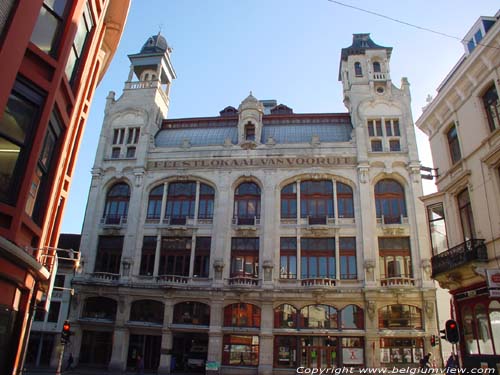
|
Lunches will be served in De Vooruit |
Conference Dinner
The conference dinner will be held on Thursday the 23rd of May in
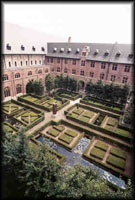
|
|
Het Pand is an old Dominican monastery located in the heart of the city on the banks of the river Leie, near the medieval port with the guildhalls as its remnants.
In 1201 a hospital was established next to Saint Michael's Chapel by Canon Utenhove. By 1225 the institute had become too small, and it was decided to construct a new one close to the Bijloke .By that time the first Dominicans had arrived in Ghent. By the agency of the then counts of Flanders, Ferdinand of Portugal and Johanna of Constantinople, the Dominicans were allocated the old hospital to serve as their new settlement.
|
The year 1228 is considered to be the official date of establishment of the monastery in Ghent. The monks were very actively constructing, and very soon they started building a fully fledged monastery. By 1240 the construction of a church was launched, and it was finished after 25 years. During the period 1325-75 the wing at the river Leie was constructed, with a sacristy, a priory, the refectory and the chapter house, a brewery and a kitchen. All over the first floor was a spacious dormitory. The corridors of the courtyard date from the 15th century, and were constructed in different periods. |

|
In 1473 Margaret of York, spouse of Charles the Bold, laid the first stone of the street wing or library wing, which was the most important extension of the monastery. In the beginning of the 16th century the construction of the middle wing was started, using sandstone for the ground floor and bricks for the upper, and applying the Tudor arch.
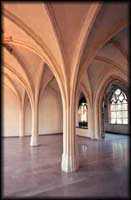
|
The Iconoclastic Fury of 1556 brought hard times for the building. The Calvinists threw all the library books in the Leie. After a brief period of peace, in 1578 the Calvinists took over the city again. The monastery was used as a Calvinist university until 1584.In 1651 the old Utenhove hospital was being pulled down and its foundations were used to construct a new hostel which was to be arranged to serve as a guest wing. The north-eastern part of the premise, with the priory and the pharmacy, was refurbished 1780-81 in Louis XVI-style, using stucco and decorative painting. The establishment of the monastery is thus spread over more then 5 centuries, the countless extensions and modifications show the busy activity of the order in the inner city. |
In 1796, after the French Revolution; the monastery was closed and sold in lots. The fathers were able to purchase the building with the help of an agent. They let some part of the building to get some income, but still they were forced to sell the property in 1823, with the consent of Pope Leo XII.
|
The new civil owner, exploiting the rising need of housing occasioned by the speeding industrialization of the city, introduced intermediate floors and partitions. In this way, some two hundred rooms became available for those with little means, while the large rooms such as the sacristy and the chapter house were being used as depots for wine and the refectory became a 'Bazar', a market of furniture. In 1860, the church was demolished. Plans were being made to build a bridge across the river, and an avenue to connect the Volderstraat and its prestigious Aula with the Coupure, where the better class citizens lived. These plans were never realized. |
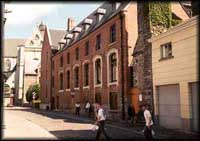
|
In view of the world exhibition of 1913, some restoration was done at the Leie front in 1912. The building affected by age had deteriorated in such a way that it became untenable after the Second World War. It was prone to be demolished. But the Decree of 29.10.1956 put the building on the list of classified premises. Thus the building was saved for future generations to enjoy.
Company Visit
Info to follow


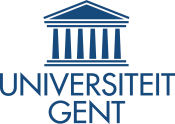
 Tel: 09.267.28.28
Tel: 09.267.28.28
 Fax: 09 264 83 96
Fax: 09 264 83 96









